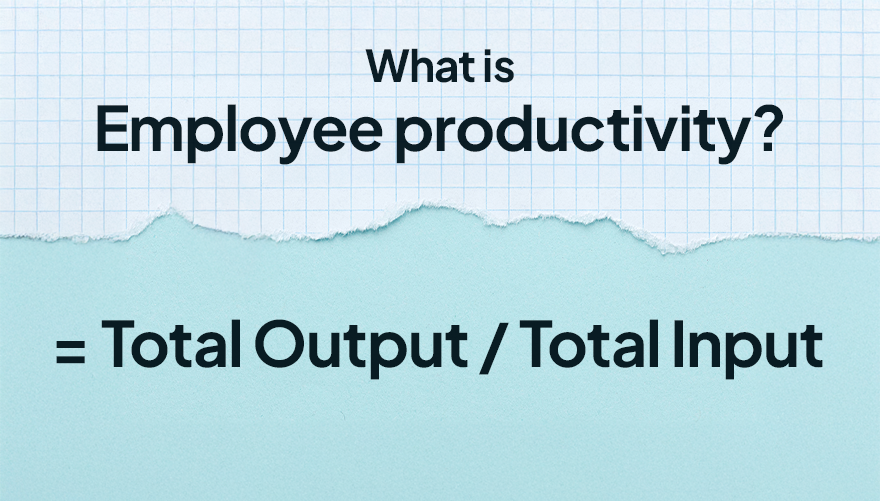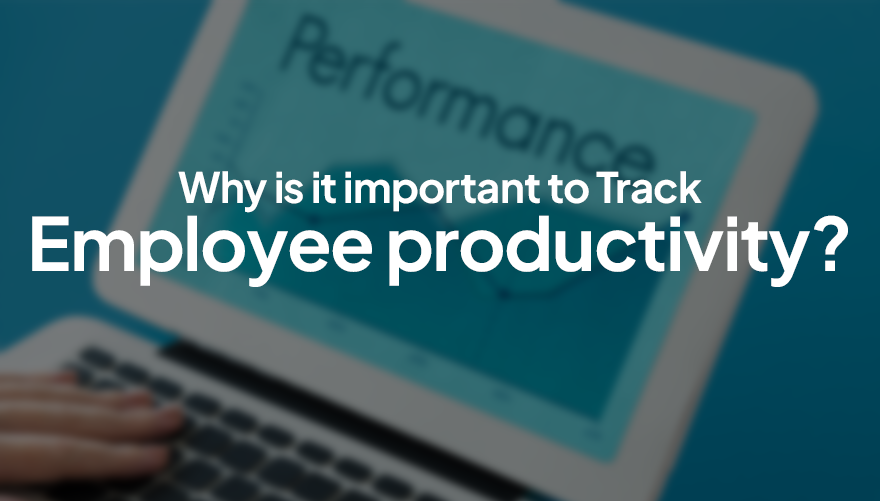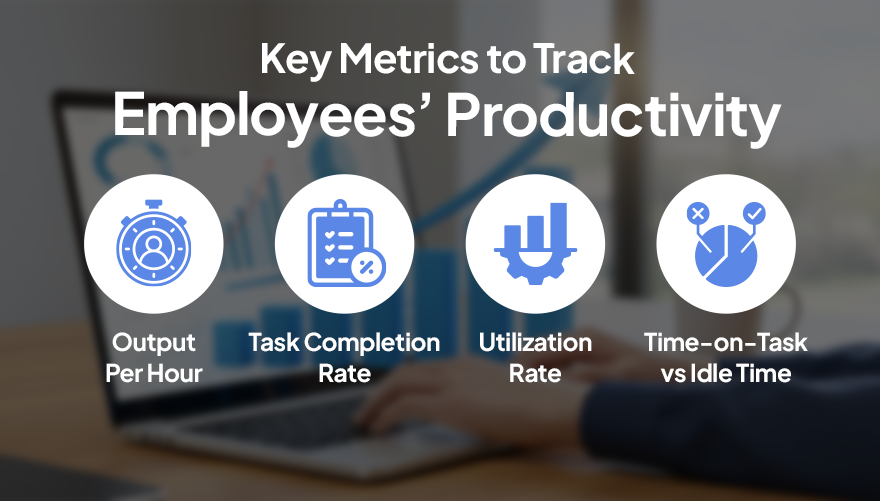Are your employees truly productive or just pretending to cover their work schedule?
In many workplaces today, those long hours and packed work schedules don’t indicate high performance. That’s why measuring employee productivity is more critical than it’s ever been.
Managers need smarter and more efficient ways to monitor performance of hybrid, on-site, and remote teams across multiple time zones. Employee monitoring software can help with real-time insight into how time is spent, which tasks are most time-consuming and where improvements can be made. More than 78% businesses use this software to accurately track and measure employees’ productivity.
Businesses need to implement strategies aligned with automated employee tracking software to measure and boost employee productivity. Tracking key metrics can give you a clear data-based solution to quantify output and identify areas where you can grow.
In this guide, we’ll explain what employee productivity actually is, why it’s important, and how to calculate employee productivity with easy formulas.
What is Employee productivity?

Employee productivity is how much productive work an employee is doing during a given period of time. It is an indication of how effectively one is utilizing their time, efforts and skills into results that support the growth of the business.
For example, if a sales representative receives 10 sales in one day and another gets 4 at the same time, the former is more productive.
A simple formula to measure employee productivity is:
Employee Productivity = Total Output / Total Input.
By understanding it, businesses can make better strategies, support their team, and build a healthy workplace for both employees and the business.
Calculate ROI with hybrid work ROI calculator.
Why is it important to Track Employee productivity?

Keeping track of employee productivity allows managers and company owners to evaluate employee performance and capabilities. The data can be used to make smart decisions that result in better performance, happier employees and better business growth.
Better Performance Management
When you keep tracking productivity, you have clear evidence as to which employees have met the mark and who has fallen short. It helps in making performance reviews more accurate and transparent for both employees and employers.
Improved Time Management
This can involve reducing unnecessary meetings or assisting employees in ranking priorities. Your team can continue focusing on valuable work and utilize their schedule with the proper adjustments.
Smarter Use of Tools
Using resources like employee monitoring software allows you to observe patterns you might miss manually, like frequent interruptions, delayed tasks or overstuffed employees. This helps managers to make changes that optimize daily processes without guesswork.

Automate Workforce productivity Monitoring with wAnywhere
Don’t rely on assumptions—track real-time productivity with wAnywhere’s employee monitoring software.
Boost Employee Productivity
When employees recognize their hardwork is being rewarded without bias, they are more likely to be motivated and feel accountable for the work. Transparency can boost trust and enable us to get the best from people. When employees receive regular feedback and have clear goals, they stay engaged.
Key Metrics to Track Employees’ Productivity

Monitoring the correct employee productivity metrics helps you have an idea of what your team is and isn’t doing. As the numbers suggest, you need to know what’s working, what’s not, and where improvement is necessary. Here are just a few of the key insights and measurements businesses should consistently be tracking.
Output Per Hour
It’s a value that identifies how much work an employee can accomplish in a defined time, most often an hour or a day. For example, the output of a content writer can be word count written. It can help you measure how efficient your team is when it comes to accomplishing work.
Task Completion Rate
The more of these tasks they accomplish, the more they stick to their targets and manage their workload. It’s helpful for identifying missed deadlines, uncompleted assignments, or team members who are overburdened or in need of additional support.
Utilization Rate
Utilization rate is the number of an employee’s working hours that go toward billable tasks versus non-billable tasks. For instance, if an employee works 8 hours but only 5 of them are working time, such individual’s utilization rate is 62.5 %. The utilization rate can help to improve time use across your teams.
Time-on-Task vs Idle Time
This employee time tracking software can automatically track employees’ idle and productive hours and provide real-time data to understand daily habits, work patterns, and productivity gaps. Managers can use this real-time data to fix bottlenecks and eliminate unproductive hours in no time.
Key Strategies to Boost Employees’ Productivity
Businesses must utilize smart methods and modern technology to track and boost employee productivity rather than just focus on expanding working hours. They must create a healthy environment, have AI-powered software and flexibility to foster a more productive team. Clear and measurable goals are the best way to improve productivity.
When employees understand precisely what’s expected, they can dedicate their time and energy to priority tasks. Implementing tools such as employee monitoring software that provides real-time visibility into employees’ performance.

Unlock Real-time Workforce Analytics with wAnywhere
Get crystal-clear visibility into how your team works from login to logout.
Feedback is also a key component of keeping employees engaged and motivated at work. When individuals’ efforts are recognized and they are informed of ways to improve, people are more likely to become engaged and stay focused and dedicated.
Providing flexible work arrangements, like remote work or flexible hours, allows employees to work when they are most productive. Additionally, investing in training and development programs can help employees to grow within their roles, increasing confidence and productivity. When such initiatives are in place, businesses are able to increase employee productivity, and build a constructive, high-performance work environment.
wAnywhere: Automate and Boost Employees’ Productivity with Ease
With reliable employee monitoring software like wAnywhere, you don’t need to stress about calculating employee productivity manually or draining yourself with formulas. Our platform automatically monitors workforce productivity in real-time and gives you actionable data to drive decisions backed by data. wAnywhere is the most user-friendly platform that offers enhanced visibility into output per hour, task completion rates, idle time vs. active time, and other essential employee productivity metrics—all under one dashboard.
With features like real-time activity monitoring, time tracking, screenshots, and more, you get in-depth workforce analytics to recognize top performers, identify underperformers, spot productivity bottlenecks, and project gaps. Using these productivity parameters, managers can optimize workflows, boost performance, and allocate resources efficiently in any work model—remote, hybrid, or in-office teams.
Turn theoretical formulas into measurable outcomes by integrating wAnywhere in your productivity strategy.
Conclusion
Workforce productivity is like a fuel that drives businesses. Achieving productivity at optimal levels is not a destination but an ongoing, evolving process. Therefore, measuring productivity from individuals to departmental levels becomes necessary because it reveals valuable data about your workforce that can be used to optimize workflows, boost ROI, and make data-driven decisions.
Use employee monitoring software that helps businesses to automate workforce analytics and performance tracking. Instead of relying on assumptions, or manual tracking methods to monitor employee productivity metrics, get real-time accurate insights with advanced workforce tracking software like wAnywhere. Start measuring what matters—and watch your productivity soar in days.

From Formulas to Real Results
Let wAnywhere track, analyze, and boost your workforce productivity—across remote, hybrid, and in-office teams.













